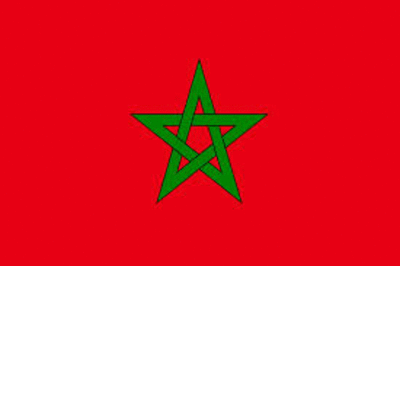national Defence
In 2004, the army numbered about 180,000 men, the air force and navy 13,000 7800 ; military service of eighteen months is mandatory for all men. The same year, the government spent 4.2 percent . 100 of Gross Domestic Product (GDP) expenditure on national defense.Morocco is engaged since 1974 in operations in Western Sahara against the Saharawi nationalist Polisario seeking independence .
Languages and religions
Arabic , the official language, is spoken by 75 percent . 100 of the population , but Berber, or Tamazight is also spoken by half of Moroccans ; (the mother tongue of at least 25 percent . 100 of the population) . Many Moroccans also speak French and Spanish.Islam is the state religion. The entire population is Sunni Muslim . The King of Morocco , a descendant of the Prophet Muhammad, is Commander of the Faithful ; Christians represent 1 p. 100 of the population and Jews less than 0.1 p. 100 .
education
In 1963, the school became compulsory for all children aged 7-13 years. The enrollment of boys is much more important than girls. In 1991, 38.2 per cent. 100 children in the relevant age group were enrolled in secondary schools; in 1993, 10.3 per cent. 100 were in the top . The instruction is in Arabic. In 1994 , King Hassan II decided that Berber is now taught in primary school, an important decision that will take some time to be acted upon . In 1995, 56.3 per cent. 100 Moroccans could neither read nor write.The traditional higher education is provided in Arabic at the University al- Qarawiyin in Fez and modern higher education in French and Arabic , universities Mohammed V ( 1957) in Rabat , Mohammed Ben Abdallah ( 1974) Fez, Cadi Ayyad (1978) in Marrakech, Hassan II (1976) and Casablanca Mohammed I. (1978) in Oujda. Rabat also has a school of fine arts and several institutes specializing in administration , agriculture and economics. The School of Arts and Popular Traditions (founded 1921) is located in Tetouan .In 1992 , the government spent 5.8 percent . 100 of GDP on education expenditure.
In 2004, the army numbered about 180,000 men, the air force and navy 13,000 7800 ; military service of eighteen months is mandatory for all men. The same year, the government spent 4.2 percent . 100 of Gross Domestic Product (GDP) expenditure on national defense.Morocco is engaged since 1974 in operations in Western Sahara against the Saharawi nationalist Polisario seeking independence .
Languages and religions
Arabic , the official language, is spoken by 75 percent . 100 of the population , but Berber, or Tamazight is also spoken by half of Moroccans ; (the mother tongue of at least 25 percent . 100 of the population) . Many Moroccans also speak French and Spanish.Islam is the state religion. The entire population is Sunni Muslim . The King of Morocco , a descendant of the Prophet Muhammad, is Commander of the Faithful ; Christians represent 1 p. 100 of the population and Jews less than 0.1 p. 100 .
education
In 1963, the school became compulsory for all children aged 7-13 years. The enrollment of boys is much more important than girls. In 1991, 38.2 per cent. 100 children in the relevant age group were enrolled in secondary schools; in 1993, 10.3 per cent. 100 were in the top . The instruction is in Arabic. In 1994 , King Hassan II decided that Berber is now taught in primary school, an important decision that will take some time to be acted upon . In 1995, 56.3 per cent. 100 Moroccans could neither read nor write.The traditional higher education is provided in Arabic at the University al- Qarawiyin in Fez and modern higher education in French and Arabic , universities Mohammed V ( 1957) in Rabat , Mohammed Ben Abdallah ( 1974) Fez, Cadi Ayyad (1978) in Marrakech, Hassan II (1976) and Casablanca Mohammed I. (1978) in Oujda. Rabat also has a school of fine arts and several institutes specializing in administration , agriculture and economics. The School of Arts and Popular Traditions (founded 1921) is located in Tetouan .In 1992 , the government spent 5.8 percent . 100 of GDP on education expenditure.
">culture
Morocco has enriched influences from many cultures, as evidenced by
the remains of civilizations Phoenician , Greek, Carthaginian, Roman and
Arabic.Christianity spread in the region with the Roman occupation and resisted for a time in the Arab expansion . The
Arab- Muslim influence prevails quickly on the coasts and in the cities
that are becoming major trade between Spain , the southern Sahara and
the rest of the Arab world's centers. Arabic , the sacred language , also became the written language of trade and cultural exchanges . Morocco
hosts Muslims and Jews expelled by the Inquisition , which prevails in
the Iberian peninsula in the sixteenth century architecture and
Arab-Andalusian music then come to influence the arts of Islam. Morocco remains , however , outside the area of Ottoman influence. The
West African footprint date of the establishment of trans-Saharan
routes in the tenth century , and the Mauritanian Almoravid dynasty ,
founders of the city of Marrakech. French colonization, for over half a century , marking the transition
of the country to the contemporary world , with the changes that this
implies in Moroccan society.The National Library of Morocco , founded in 1920 , is located in Rabat. Casablanca and the University of Fez also home libraries. The
main museum is the Archaeological Museum in Tetouan, whose collection
is composed of remnants Carthaginians, Romans and Muslims.
do you like this؟ share! ↓















